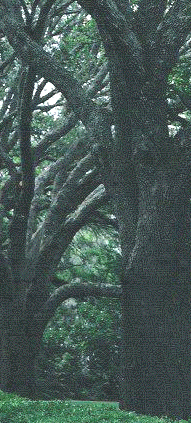|
"Purchase 25mg cozaar visa, diabetes definition canadian". By: G. Abbas, M.S., Ph.D. Co-Director, Keck School of Medicine of University of Southern California
Buy 25mg cozaar mastercardTherefore blood sugar fluctuations symptoms order cozaar on line, as the alveoli turn into smaller diabetes cdc cozaar 50 mg generic, the sur face tension also reduces and because the alveoli distends (becomes larger) diabetic vitreopathy generic 25 mg cozaar amex, surface tension increases diabetes type 1 pictures purchase 25 mg cozaar with amex. The Laplace legislation explains the relationship of floor rigidity Chapter 104: Mechanics of Breathing 899 Role of Surfactant in Pulmonary Mechanics the internal lining of alveoli is coated by surfactant. The pulmonary surfactant is a thin liquid movie of alveolar lining that decreases floor tension at the gas liquid interface of alveoli and alters floor tension with change in alveolar diameter. Pulmonary Surfactant Structure and Composition Pulmonary surfactant is a combination of lipoprotein wealthy in phospholipid. The alveolar floor pressure is inversely proportional to the focus of phospholipids in the sur factant. Lamellar inclusion bodies are repeatedly discharged onto the alveolar floor by constitutive exocytosis (exocytosis which is continuous and unregulated). The launched lamellar bodymaterials are transformed into tubular myelin that varieties the film of surfactant on the alveolar floor (steps of surfactant synthesis are summarized in Flowchart 104. The lively synthesis of lipid in the lung accounts for top rate of substitute of surfactant. Thus, an inte grated layer of surfactant is constantly formed on the alveolar epithelium. Time of Surfactant Synthesis in Fetal Life Lungs are among the final organs to develop throughout intra uterine life. Surfactant synthesis begins at about 34 weeks of pregnancy, which is accomplished by about 90% at term (38-40 weeks). That means, maturation of surfactant production continues to the perinatal interval. Therefore, inadequate surfactant synthesis resulting in lung collapse is among the major causes of dying in untimely deliveries. Synthesis and Secretion Palmitate, choline and glucose are substrate molecules for surfactant synthesis. Regulation of Synthesis and Secretion Surfactant synthesis is regulated by hormones, concen tration of protein in the surfactant, stretching of lung and varied pharmacological brokers. Pharmacological agents � adrenergic agonists enhance surfactant secretion � Calcium stimulates surfactant secretion. Exercise Practice of regular bodily train stimulates surfactant synthesis in each youngsters and adults. Prevents lung collapse: Surfactant decreases surface tension on the airliquid interface of alveoli. During lung deflation, compression of surfactant mol ecules decreases floor rigidity. During lung inflation, new surfactant is extruded onto the alveolar floor that varieties a new film on the alve olar epithelial lining. Promotes alveolar stability: In lungs, alveoli of dif ferent diameters are related in parallel to one another. Surfactant achieves this by lowering floor rigidity proportionately more in the smaller alveoli. Helps to forestall edema within the lung: the inward drive of surface tension that tends to collapse alveoli additionally tends to lower interstitial strain in the lungs. Decreased interstitial strain pulls fluid out of capi llaries and facilitates pulmonary edema formation. On work of respiration: Surfactant decreases the work of respiration, in order that breathing turns into simpler. Number of glucocorticoid receptors in lungs also increases in third trimester of pregnancy. Quantity and high quality of proteins in surfactant Formation of phospholipid film of surfactant is significantly facilitated by proteins current in the surfactant. Surfactant proteins are albumin, immunoglobulin (IgA) and apopro teins (surfactant proteins). The protein content of surfactant depends on concen tration of protein within the plasma. Stretching of lungs Hyperinflation of lungs like yawning enhances surfactant synthesis.
Purchase 25mg cozaar visaTherefore diabetes prevention program va discount cozaar online amex, C peptide evaluation is done in good laboratories to assess b cell practical standing diabetes insipidus journal pdf purchase cozaar 25 mg otc. Binding of insulin with a-subunit causes autophosphorylation of intracellular a half of b-subunit of the insulin receptor diabetic diet quick weight loss buy generic cozaar 50mg line. The major target tissues of insulin are liver blood glucose elevated order generic cozaar on line, skeletal muscle and adipose tissues. The a subunits are present on the membrane extracellularly, whereas the b subunits traverse the membrane. Thus, b subunits have extracellular domain, membrane domain, and intracellular domain. The insulin receptor gene is located on the chromosome 19, which belongs to the superfamily of genes that code for other progress elements also. The hormone is degraded in the cytoplasm, whereas the receptor is either degraded, or saved or recycled again to the membrane. This is amongst the mechanisms by which insulin resistance (decreased sensitivity to insulin) develops in obesity. The binding of insulin to a subunits brings about con formational change within the b subunits. Autophosphorylation triggers phosphorylation of many intracellular proteins that alter cell functions. The insertion of various protein channels on the plasma membrane will increase entry of amino acids, potassium, magnesium, and phosphates into the cell. Activation of mitogenic proteins increases transcription of varied elements that are essential for stimula tion of gene expression, especially involved with cell growth. This prompts the enzyme glycogen synthase, a key enzyme that modulate the metabolic effects of insulin. Thus, exercise promotes glucose uptake by the cells and reduces blood glucose degree. As acute train significantly decreases blood glucose stage by facilitating glucose uptake by skeletal muscles, and during exercise absorption of injected insulin is extra speedy, hypoglycemia may be precipitated in diabetic sufferers during train. Therefore, diabetic patients ought to lower their insulin dose after they exercise or they need to take additional calorie just prior to train. This means of glucose entry in to the cell is increased by about 20 times by the activation of a glucose carrier system in the plasma membrane: 1. Insulin facilitates storage of nutrients when nutrients are present in extra of the vitality want. The stored vitamins are made obtainable on the time of want like train, fasting, and so on. Insulin produces its goal results by appearing primarily on the liver, adipose tissue, and skeletal muscle. On Carbohydrate Metabolism Insulin increases glucose entry into the cell, stimulates its oxidation and promotes also its storage. Therefore, the first function of insulin is to lower the plasma glucose concentration. It is the only hormone that decreases plasma glucose level (decreases basal glucose degree and in addition pre vents rise in plasma glucose following feeding). The antidia betogenic features of insulin are mediated by its action on liver, adipose tissue and muscle. Glucose Transporters Glucose enters the cell via facilitated diffusion or by secondary active transport with sodium in intestine and kidney. In Liver In liver, insulin promotes glucose storage and prevents its production by following mechanisms (Flowchart 60. Insulin facilitates glucose entry into the hepatic cell by inducing the motion of the enzyme glucokinase. Thus, by facilitating glucose entry into the cells and also concurrently converting glucose into glucose-6 phosphates, insulin keeps cytoplasmic glu cose concentration at lower level. It stimulates glycolysis by activating the enzymes phosphofructokinase and pyruvate kinase. Pyruvate and lactate are additionally oxidized by insulin because it stimulates pyruvate dehydrogenase exercise. Thus, insulin decreases the cellular focus of glucose and consequently helps in its facilitated diffusion into the cell.
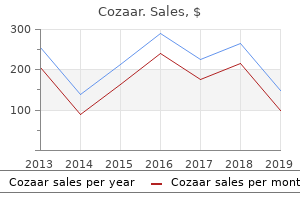
Effective 25 mg cozaarThey play position in contractile functions of cardiac muscles which might be regulated by electrical gradient diabetes mellitus type 2 family history order cozaar online. Therefore diabetes mellitus natural treatment order cozaar 25 mg with visa, the reversal potential of If is about �20 mV diabetes type 1 weight loss diet discount cozaar master card, between the Nernst potentials for K+ (about �90 mV) and Na+ (about +60 mV) blood glucose range generic 25 mg cozaar visa. It contributes to section 1 repolarization by tran siently allowing outflux of K+ at optimistic membrane potential. This found plentily in atrial myocytes, Purkinje fibers, and ventricular myocytes. They are liable for repolarizing the membrane at the end of the motion potential (phase 3) by allowing outflux of K+ after a delay when membrane repolar izes. However, action potential vary from slow to fast sort in different tissues of the guts. Fast Response Action Potential Fast response sort of motion potential is recorded from atrial and ventricular muscle tissue and Purkinje fibers. Ach performing on muscarinic receptors stimulates -subunits of G protein, which in turn activates the K+ channels. In ventricular muscles and Purkinje fibers, this channel additionally hyperpolarizes the membrane during part four. Phases and Ionic Basis Typically 5 phases (phases 0�4) are observed in a quick response motion potential as recorded from ventricular muscle fibers. As quickly because the membrane potential reaches threshold, rapid depolarization (a steep rise in the spike) happens. This is due to sudden enhance in the permeability of the membrane to sodium ions, which occurs because of hun dredfold opening of voltagegated sodium channels. In reality, immediately above the threshold level of the membrane potential, initially activated sodium chan nels activate other sodium channels (autoactivation) that ends in manifold opening of the channels. This part of partial repolarization is as a outcome of of closure of sodium channels (cessation of sodium influx). Opening of outward transient rectifying K+ channel that causes transient outflux of K+ also partly contrib utes. A Phase 2 this is called plateau part as the action potential in this phase stays in a state of sustained depolarization. This phase is as a end result of of sustained increased permeabil ity of the membrane to calcium ions (through slowly opening calcium channels) that ends in sluggish calcium inflow, which occurs due to slower but prolonged opening of voltagegated calcium channels. The plateau phase is of much lesser length in atrial muscle than the ventricular muscles. This occurs because of cessation of calcium inflow (closure of calcium channels) and elevated membrane per meability to potassium (increased potassium efflux). Phase 0: Phase of depolarization; Phase three: Phase of repolarization; and Phase 4: Phase of slow depolarization to threshold. Phase 3 this section is due to closure of calcium channels and opening of the potassium channels (increased potassium efflux). The relative enhance in permeability to K+ drives the membrane potential in direction of the equilibrium potential. The early part of this part is because of the closure of potassium channels (decreased potassium conduct ance). Calcium sparks (release of calcium regionally from sarcoplasmic reticulum) also con tributes. The automaticity (the ability of the pacemaker to produce its personal impulse) is feasible as a outcome of spontaneous diastolic depolarization of the membrane potential following completion of every motion potential. The resting (diastolic) membrane potential that depolar izes known as as the prepotential as it brings the membrane potential to the edge level, which then triggers the action potential. Phases and Ionic Basis Slow response action potential consists primarily of three components. The depolarization is mainly as a outcome of influx of calcium ions by way of the lengthy appearing calcium channels (Lcal cium channels). Ionic Basis Ionic basis of pacemaker potential has two essential components: the ionic basis at preliminary half and on the later part of the potential. In the Initial Part the repolarization phase of the motion potential within the nodal tissues is due to efflux of potassium ions. Toward the tip of repolarization, the Ik declines, which is called potassium decay. The entry of calcium by way of the T-channels com pletes the pacemaker potential and takes the mem brane potential to the threshold stage, which then fires to type the motion potential.
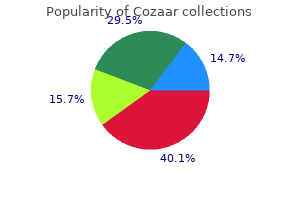
Buy 25mg cozaarTherefore blood glucose after exercise cozaar 25 mg on-line, though colon receives about 2 liters of chyme per day from small gut diabetes in dogs treatment naturally order cozaar 50mg with mastercard, its output is just about 200 mL diabetes type 1 herbal treatment order cheap cozaar line. The objectives of colonic contractions are to mix the chyme and flow into it across the mucosal surface of the colon in order that maximum contact occurs between the chyme and the mucosal epithelium blood glucose vs plasma glucose levels generic 50 mg cozaar with visa. This, plus the slow movement of the chyme across the colon, which is about 5�10 cm/hour allows maximum absorption of salt and water. Longitudinal muscle layer of muscularis externa is concentrated into three bands, known as as tenia coli. Colonic Movements Colonic actions include haustral contractions, propulsive actions, mass peristalsis, and colonic reflexes. Note, absence of villi, many goblet cells within the mucosal epithelium, outer longitudinal muscle layer is specialized into tenia coli. Mass Peristalsis Mass colonic peristalsis is a stronger peristaltic contraction that forcefully pushes the contents from colon into the rectum. Activation of mass peristalsis in colon lastly results in the initiation of defecation reflex. Parasympathetic innervation to cecum, ascending, transverse and most part of descending colon comes via vagus nerve, whereas innervation to the sigmoid colon, rectum, and anal canal comes through pelvic nerves that arise from the sacral spinal wire. Sympathetic fibers to massive gut come through superior and inferior mesenteric plexuses, and superior and inferior hypogastric plexuses. Parasympathetic stimulation will increase and sympathetic stimulation decreases colonic movements. Colonic Reflexes Colonic reflexes embrace colonocolonic reflex and gastrocolic reflex. Colonocolonic Reflex Colonocolonic reflex is the relaxation of the whole colon in response to distention of 1 part of the colon. Electrophysiology of Colonic Muscle Colon consists of both circular and longitudinal muscle. Gastrocolic Reflex Gastrocolic reflex is initiated when food accumulates in the abdomen. This pushes colonic content material into the rectum, which stimulates the will for defecation. Therefore, usually after taking a big meal, the urge for defecation is enhanced. Gastrocolic reflex is proposed to be mediated by gastrin secreted from abdomen in response to gastric distension, and never by neural components. Circular Muscle There are two types of tempo making (rhythm generating) cells within the colon. The one set of cells that are current close to the inside border of round muscular tissues produce common gradual waves of high amplitude like that of gastric sluggish waves. The chyme that comes out from the gut is collected in a colostomy bag fastened across the colostomy opening. Anal canal at all times remains closed by the tonic contractions of internal and exterior anal sphincters. The internal anal sphincter is made up of thickening of round smooth muscle of the anal canal. Thus, external sphincter is innervated by somatic motor fibers via pudendal nerves, which brings it underneath voluntary management. Before initiation of the defecation reflex, colonic peristalsis pushes colonic contents into the rectum. This causes filling and distension of the rectum that initiates leisure of inner anal sphincter and constriction of exterior anal sphincter. The heart for defecation is current in the sacral portion of the spinal cord, which is influenced by higher facilities. The efferent pathway includes cholinergic parasympathetic fibers in the pelvic nerves.
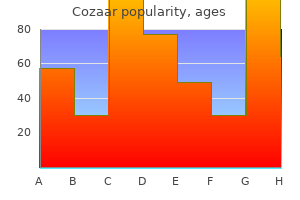
Buy cozaar onlineFor instance diabetes medications that don't cause weight gain 25mg cozaar amex, when sym pathetic activation occurs during exercise to enhance coronary heart fee blood glucose 101 purchase 25mg cozaar free shipping, simultaneous decrease vagal activity also contributes to obtain the target improve in coronary heart price diabetic diet guidelines mayo clinic order genuine cozaar. For instance diabetes insipidus yahoo answers order genuine cozaar on-line, to enhance gastrointestinal secretions, when parasympathetic stimulation increases quantity and enzyme content material, simultaneous sympathetic activation contributes to increased mucus content of the secretory product. It has a reciprocal influence on organ functions to that of sympathetic affect. In fact, it checks the overactiv ity of sympathetic system and smoothens the autonomic responses. The cell bodies are discovered within the brainstem cranial nerve nuclei (cranial component), and in essentially the most caudal a half of the spinal wire (spinal or sacral component). Also, few buildings corresponding to blood vessels and skin obtain only sympathetic innervation and due to this fact, their functions are regulated by alteration within the fee of sympathetic discharge to these constructions. Receptors Receptors are situated in the physique floor or in the muscu loskeletal system in somatic system. The cell bodies of autonomic motor neurons are situated in the intermediolateral horn of spinal wire or in the specific brainstem cranial nerve nuclei. The neuron from the ganglion then tasks as postganglionic axon to the effector cells (usually a visceral organ). Afferent Pathway the afferent neurons of somatic system enter spinal cord through dorsal root with their cell our bodies in the dorsal root gan glion and terminate on interneurons in deeper layers of dorsal horn or on motor neurons in the ventral horn. Central Neurons Central part in somatic system consists of the cell body of a motor neuron in the ventral horn of the spinal twine on which the afferent neuron immediately terminates monosynaptically. The afferent neuron may also contact motor neuron by way of interneurons by way of disynaptic or poly synaptic connections. The first efferent neuron is the preganglionic neuron that has cell physique within the intermediolateral horn of spi nal cord or within the cranial nerve nuclei in brainstem. The second efferent neuron is the postganglionic neuron that has cell physique within the ganglia exterior the spinal cord or within the effector organ. The preganglionic neurons go away spinal twine via white rami communicantes to the paravertebral sympathetic ganglion where they contact cell our bodies of postgangli onic neuron, the axons of which terminate on effector organ. The postganglionic sympathetic neurons to head originate from superior and center cervical ganglia and stellate ganglion. Axons of preganglionic neurons give collaterals to ter minate on another set of cell our bodies in the paraver tebral ganglion chain. Axons of those postganglionic neurons enter gray rami communicantes and from there enter into the spinal nerve to lastly innervate the effector organs. In this efferent pathway of sympathetic system, the preganglionic fibers are longer than the postganglionic fibers. In parasympathetic system, the preganglionic neurons of cranial half originate from cell bodies in the cranial nerve. The preganglionic neurons of sacral part observe an identical route besides that the fibers originate from cell bodies within the intermediolateral horn of spinal wire and traverse in spinal nerve. In basic, in sympathetic system, the preganglionic fibers are smaller than the postganglionic fibers (Appli cation Box 30. The electrical exercise for discharge of autonomic fibers originates in a few of the effector cells and then propa gates to cells of rest of the tissue through hole junctions. Preganglionic nerve terminals of each the sympathetic and the parasympathetic divisions. Postganglionic sympathetic neurons to sweat glands and blood vessels in skeletal muscle. The synapse at preganglionic nerve terminals utilizes nicotinic receptors much like that found at neuromuscular junction. The synapse between the postganglionic neuron and the target tissues utilizes muscarinic receptors. The receptor classification is predicated on the response of the syn apses to the alkaloids nicotine and muscarine at respec tive type of synapse. The nicotinic receptor is blocked by hexamethonium in autonomic ganglion, in distinction to blockade by curare at neuromuscular junction. The nicotinic cholinergic receptor is of direct ligand-gated sort because it incorporates ion channel in it.
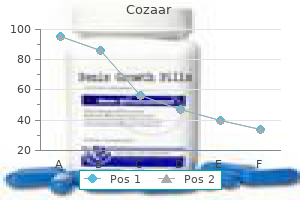
Starbloom (Pink Root). Cozaar. - Removing intestinal worms.
- Dosing considerations for Pink Root.
- How does Pink Root work?
- Are there safety concerns?
- What is Pink Root?
Source: http://www.rxlist.com/script/main/art.asp?articlekey=96831
Cheap cozaar 50 mg without prescriptionFrom pelvic colon to rectum diabetes mellitus katze symptome purchase cozaar 50mg mastercard, the transit could be very sluggish diabetes mellitus type 2 signs and symptoms buy cozaar without prescription, which can take 2 to 3 days managing diabetes guidelines order cozaar with paypal. Transit time is less in high fiber food regimen managing diabetes 770 proven 50 mg cozaar, typically may even be decreased to 6 hours via the complete gut. Stimulus Defecation reflex is initiated when mass peristaltic movement of the descending and sigmoid colons pushes the colonic content material into the rectum (filling of the rectum). As the external anal sphincter is innervated by somatic nerves, the voluntary effort can additionally be necessary in initiating defecation. However, usually defecation is inhibited by the acute anorectal angle, which is about 90�, and contraction of external sphincter and puborectalis muscle. Receptors for defecation reflex are stretch receptors positioned within the wall of rectal rectum. Afferent data from the wall of rectum is conveyed to sacral segment (S3) of spinal twine via pelvic nerve. Efferent enter from spinal twine to rectum and inner anal sphincter comes via pelvic nerve and to exterior anal sphincter via somatic nerve. Higher heart, especially cortex influences spinal twine center by way of corticospinal pathway. Relaxation of internal anal sphincter is as a result of of inhibitory signals that originate in myenteric plexus in response to peristaltic wave approaching anus. Thus, it has both reflexive (automatic) and voluntary Chapter 50: Motility of Large Intestine 419 Mechanism the person sits on bathroom and strains. This increases intra-abdominal pressure, which forcefully expels the rectal contents by way of the anal canal. This is assisted by leisure of external anal sphincter, decreased anorectal angle and relaxation of puborectalis muscle. Evacuation of bladder is preceded by a deep respiration that pushes the diaphragm downward. Contraction of respiratory muscular tissues increases intrathoracic and intra-abdominal pressures. When all these mechanisms elevate the intra-abdominal stress to about 200 cm of H2O, the feces is compelled out through the exterior anal sphincter. Features Clinically, it manifests as stomach distention, anorexia and lassitude. Oral rehydration therapy is the quick treatment to forestall quantity and electrolyte loss. However, evacuation of bowel and bladder can be achieved by activating mass reflex in paraplegic sufferers. However, the physiological basis is the decreased intestinal motility that causes stasis of chyme within the large gut, which facilitates water absorption and dehydration of intestinal contents. Feces Stool is a semisolid mass of about 200�250 mL excreted kind massive intestine per day. Bacteria and inorganic materials represent 30% and 15% of the entire solids respectively. The composition of feces is comparatively not affected by diet as a large fraction of it comes from non-dietary origin. The scent of feces is due to presence of indole and skatole, the amines which would possibly be produced by colonic bacterial flora. Irritable Bowel Syndrome this condition has been recognized by a number of synonyms such as mucous colitis, spastic colon, irritable colon, and colonic neurosis. In India this is very common and lots of instances used to be misdiagnosed as persistent amebiasis in the past. Changes in gut motility are noticed in a number of studies although they poorly correlate with the symptoms. In the constipated selection the frequency of excessive altitude peristaltic contraction is less whereas nonpropulsive segmentation contractions are more. Moreover meals induced hypermotility of the colon occurring normally about one hour after the meal is lowered in many sufferers.
Buy genuine cozaar on lineThis permits hypoxic drive to further increase minute ventilation and then attain a steady state diabetic diet shopping list cheap cozaar generic. Acclimatization at High Altitude When a person ascends to high altitude and stays there for longer intervals diabetes prevention vegetarian buy cozaar cheap, he slowly gets tailored to the model new setting diabetes symptoms high sugar levels order cozaar online now. The acclimatization at excessive altitude starts within twelve hours and may take a number of days and even weeks to complete diabetes type 2 education purchase cozaar line. Adaptive changes mainly have an result on respiratory and cardiovascular systems, and blood and tissues. The major objective of those modifications is to enhance oxygen provide to the tissues. Hematological Changes the hematological adjustments that improve oxygen supply to tissues embody elevated red cell manufacturing and improved oxygen transport. Ep-induced erythropoiesis begins in about three days and continues until the particular person stays at excessive altitude. This helps the response of the respiratory center to hypoxia to proceed so that pulmonary ventilation is maintained at larger ranges. Though ventilatory response decreases slowly after four days, it remains completely above the pre-exposure level. After about four days of acclimatization, ventilatory response slowly increases, which additionally is determined by the level of altitude. Cardiovascular Changes In the early part, coronary heart rate, cardiac output and blood pressure improve. Hypoxia causes vasodilation in the systemic circulation that adds to increase in blood circulate and oxygen provide to the tissues. Though increased pink cell mass improves oxygenation of tissue, important polycythemia (increased hematocrit) increases viscosity of blood, which in flip will increase the workload on the heart. Chapter 109: Physiological Changes at High Altitude 949 Tissue Changes Following tissue changes happen, particularly within the skeletal muscular tissues: 1. Angiogenesis (release of chemical compounds from the hypoxic tissue stimulate formation of recent blood vessels). Pulmonary Hypertension and Edema Pulmonary hypertension happens due to extended publicity to hypoxia. In continual hypoxia, clean muscles in pulmonary arteries endure hypertrophy and hyperplasia that trigger narrowing of the arterial lumen. Pulmonary hypertension also will increase the workload on the right side of the guts, which can trigger proper ventricular hypertrophy, and in severe circumstances right-sided heart failure. Cerebral Edema the elevated capillary permeability leads to cerebral edema, which can be associated with disorientation and ataxia. If the features of illness still persist, especially cerebral and pulmonary edema continues, following treatment ought to begin. Diuretics: Diuretics are very helpful for the therapy of cerebral and pulmonary edema. It inhibits carbonic anhydrase and will increase bicarbonate excretion in urine, thus decreases alkali load. Nifedipine: Calcium channel blockers like nifedipine assist to reduce pulmonary arterial pressure. Acute Mountain Sickness Sudden exposure to high altitude results in growth of certain indicators and symptoms which might be together referred to as "Acute Mountain Sickness". Usually, people develop fatigue, dyspnea, nausea, vomiting, diarrhea, headache, insomnia and palpitations. These symptoms seem inside four to eight hours of arrival at excessive altitude and may final for a number of days. In severe hypoxia or in prone people, pulmonary and pulmonary cerebral edema develop. Though compensatory mechanisms are activated to ship O2 to tissues, acute ascent to a very high altitude could additionally be deadly.
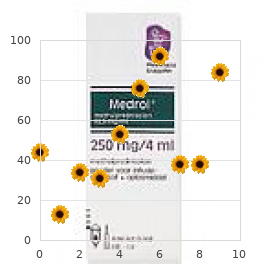
Safe cozaar 50mgThe intrapleural strain will increase to 100 mm Hg or more and then glottis opens instantaneously inflicting an explosive outflow of air at a velocity of about 600 miles per hour diabetes mellitus medical definition cozaar 50 mg online. However diabetes type 2 how to control purchase cozaar overnight, the cough responses to tracheal stimulation remains intact as innervation of trachea in not interfered in such persons diabetes symptoms pre diabetes cozaar 50 mg visa. But diabetes mellitus xxs buy cheap cozaar 25mg, cough reflex in response to stimulation of smaller airways is absent in them. Interestingly, pattern of breathing at rest, yawns and sighs in them stay regular, which indicates that these breathing responses do no depend upon lung innervation. Chapter 108: Regulation of Respiration 945 Afferents from Baroreceptors Afferent fibers from baroreceptors situated in carotid sinus, aortic arch, ventricles and atria relay in medullary respiratory centers, in addition to their relay in medullary cardiovascular facilities. Usually, impulses originating from these baroreceptors inhibit respiration, which has momentary and delicate impact. Afferents from Higher Centers Afferents from limbic system and hypothalamus terminate in brainstem respiratory facilities. Afferents from neocortex to respiratory motor neurons within the spinal wire mediate the voluntary control respiration. Breathing During Sleep Sleep occurs due to removal of excitatory influences that come up from the brainstem reticular formation. Reticular activating system has tonic excitatory drive on medullary respiratory neurons. Therefore, one may expect that sleep would result generally respiratory inhibition. In general, throughout sleep, because the stimulus of wakefulness is removed, respiration is depressed with the deepening of sleep and when wakefulness returns as sleep lightens, respiratory is activated by the carbon dioxide accrued during the interval of sleep. This periodic pattern of breathing if exaggerated is known as Cheyne-Stokes respiration, which often occurs in gradual wave sleep. Breathing stays conscious of carbon dioxide during slow-wave sleep although the sensitivity is decreased. In fact, during gradual wave sleep, in the absence of the wakefulness-stimulus, carbon dioxide-stimulus offers the major background medullary excitation for secure respiration to proceed. Therefore, alterations within the carbon dioxide-stimulus in diseased situations end in melancholy in breathing during slow-wave sleep. Stimuli that cause cough, tachypnea, and airway constriction throughout wakefulness often cause apnea and airway dilation throughout sleep. Repeated and prolonged obstruction ends in important hypercapnia and hypoxemia that causes repeated arousals from sleep. The particular person wakes up and breathes usually for someday and sleeps again to have another bout of apnea. These people develop morning headache and fatigue due to frequent apnea within the evening. In central sleep apnea, the primary cause is the decreased neural output from medullary respiratory middle to the phrenic motor neurons that provide diaphragm. These center obtain inputs from greater facilities primarily, hypothalamus and limbic methods. Medullary respiratory facilities, Pontine respiratory facilities, Effect of transaction of brainstem at varied levels on respiration, Effect of hypoxia on air flow, Effect of hypercapnea on air flow, Hering-Breuer reflex, are requested as Short Questions in exam. Say the altitude at which vital hypoxia occurs, and the utmost height as a lot as which adaptation happens. List the respiratory, cardiovascular, hematological and tissue adjustments at excessive altitude. Scientist contributed Paul Bert (1833�1886), the French physiologist developed fundamental research on relation of oxygen rigidity to physiological processes, which made the muse for examine of aviation and high attitude physiology. Stages of Compensation the hyperventilation induced by hypoxia at excessive altitude seems in two levels: In First Stage In the primary stage that appears instantly on publicity to hypoxia air flow will increase immediately though the rise in air flow is small compared to the increase in air flow within the second stage. The hyperventilation in first stage is especially because of hypoxic stimulation of the carotid our bodies. To deliver normal amount of oxygen to the tissues, many compensatory mechanisms are activated. The sustained increase in air flow is due to the ventilatory acclimatization at excessive altitude. References:
|


